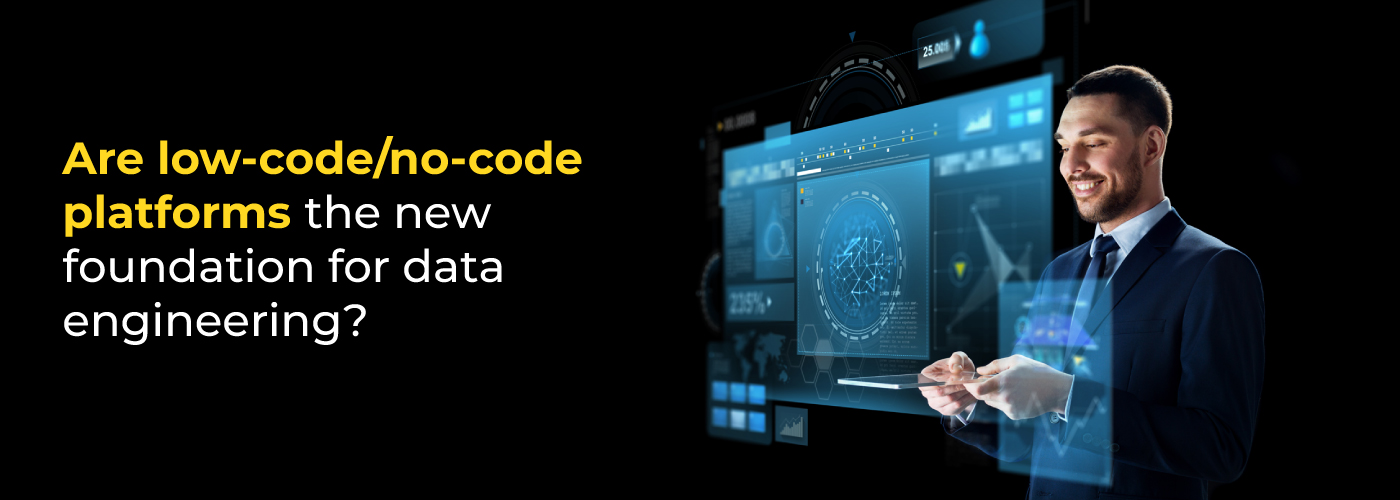
Sign up to receive latest insights & updates in technology, AI & data analytics, data science, & innovations from Polestar Analytics.
If you're still "thinking about experimenting" with Low code No Code (LCNC) platforms because you see it as an "emerging trend," you've got it backwards.
Just few years ago, less than 25% new enterprise apps used low-code. Today , that number has surged to 80%. What changed you ask? Low-code platforms aren't just workflow builders anymore. We've moved from coding pipelines to orchestrating intelligent systems (thanks to agentic AI) that govern themselves.
Data engineering bottlenecks are not new. Every new SaaS integration meant weeks of custom connector development. Or schema changes that broke pipelines without warning. Business teams waited months for simple data transformations because everything required manual-coding.
Hence, initially LCNC platforms began as tools for citizen developers’ enablement with department specific applications. Over time, a few matured into enterprise-grade infrastructure capable of handling complex automation, data democratization, and now even AI-powered orchestration.
Here's what changed for data engineers: instead of building custom connectors for every API, you configure pre-built ones. Instead of writing complex SQL for standard transformations, you use visual interfaces. Instead of manual schema drift monitoring, platforms handle it automatically. You focus on complex business logic instead of repetitive integration work.
Today, we’re seeing the results of this evolution. With low-code development platforms, 61% of users successfully deliver custom apps on time, on scope, and within budget. And Low code shows the potential to speed up software development by up to 10 times.
But here's what most organizations miss: knowing where the industry is heading means nothing if you don't know where you stand right now.
Most enterprises fall into one of three maturity levels:
The stakes matter because each level requires fundamentally different strategies, governance models, and risk profiles.
Get started with a low code data engineering platform
Get started with Data NexusEvery data engineer knows this reality: what used to be a simple ETL job from three systems now involves managing 15+ APIs, each with different rate limits, authentication schemes, and breaking changes.
Here's what you're paying for this complexity:
The real cost isn't the SaaS subscription; it's the engineering hours. Each new tool demands custom connector development, OAuth flow management, and constant schema drift monitoring. Your pipeline maintenance overhead scales exponentially while your team size stays flat.
Technical Reality Check:
The cost of technical debt accumulates faster than you can pay it down.
Data Nexus eliminates this integration tax. Through Nexus, you connect to any system (cloud databases, ERPs, flat files, APIs, data warehouses) without custom development. The platform provides pre-built connectivity that handles authentication, rate limiting, and schema evolution automatically.
Here's the time difference. In terms of writing the code and framework it expedites the process by 70%. Which means when it comes to task selection, simple configurations replace complex integration development. And you focus on data transformation logic instead of connection overhead.
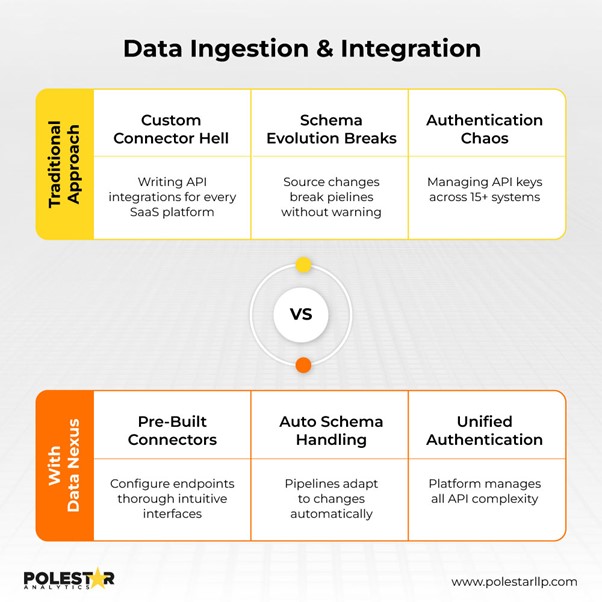
Where there’s transformation, there must be a bottleneck. And for data transformation it can be a simple business question like: "How much are we paying employees in different cities?" Three months later, you're still wrestling with mismatched schemas and duplicate records.
What looks like a straightforward query becomes a multi-system integration project – with schema reconciliation, data deduplication, or quality validation. Each of these tasks requires specialized skills and substantial development time.
This is where traditional data engineering gets bogged down:
LCNC platforms solve this differently. Drag-and-drop transformations handle standard operations like joins, deduplication, and aggregation as configuration options. You apply business logic through simple column conditions without writing code which enables you to spend time on complex business logic instead of repetitive data wrangling.
P.S. Taking nearly 50-70% of the time vs manual.
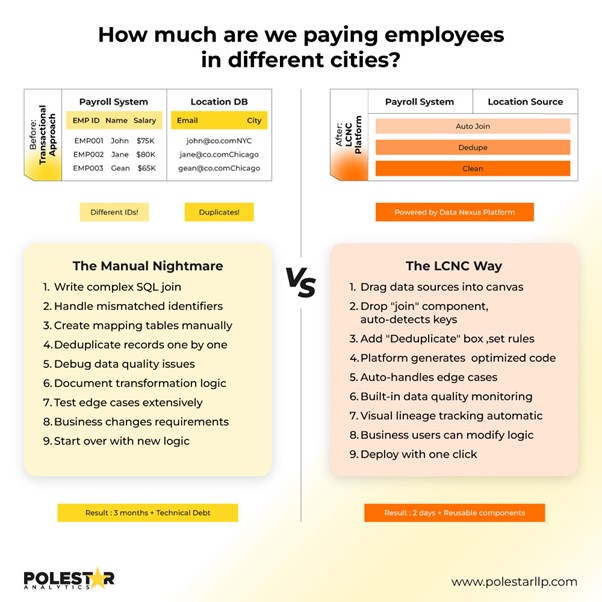
You've solved the transformation bottleneck and can now answer "How much are we paying employees in different cities?" But here's the deeper problem: which version of "John Smith" is the real one?
The need of having analytics or AI-ready data is higher than ever. With 1Platform’s Data Nexus we embed this ideology of having analytics ready data, throughout with a medallion architecture based process:
This approach helps unify the organization's overall view of data while enhancing its technical capabilities.
Data governance turns data engineers into firefighters. When auditors ask for lineage, you scramble through spreadsheets and hunt down whoever built that pipeline. GDPR requests mean manually hunting through dozens of systems. Business teams build shadow workflows, then IT gets blamed when compliance discovers them.
Traditional tools scatter governance across systems. Access controls in five different places. Audit logs requiring manual correlation.
LCNC platforms like 1Platform centralize this with:
When auditors ask questions, you query the platform's metadata instead of playing detective across systems.
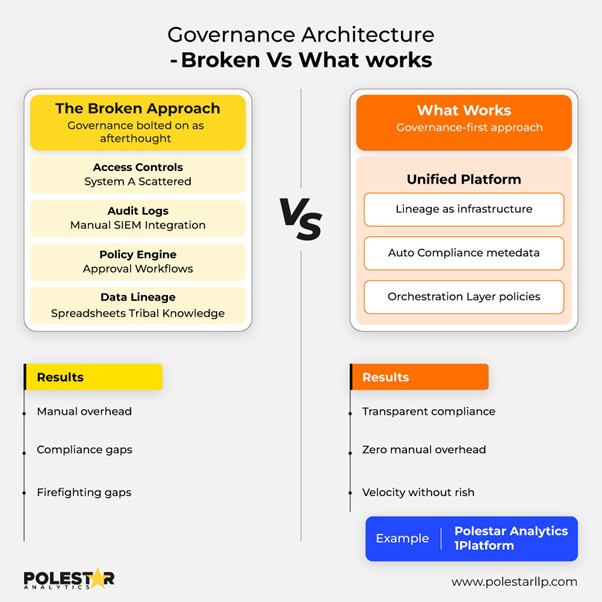
Intelligent platforms make governance part of your engineering DNA with built-in lineage, automated compliance, scalable access controls.
Discover LCNC for data engineeringWith 93 percent of IT leaders reporting intention to introduce autonomous AI agents within the next two years, and nearly half have already done so - your architecture decision matters more than ever.
Not only there are data agents that will detect schema changes, adapt pipelines automatically, and resolve data conflicts without human intervention.
But you would also need clean data to let the industry-specific agents work at maximum efficiency.
So, your data applications, AI agents, and analytics need to work from one foundation. Not just API connections between tools—actual architectural unity where data flows from ingestion to AI processing to automated actions without crossing system boundaries.
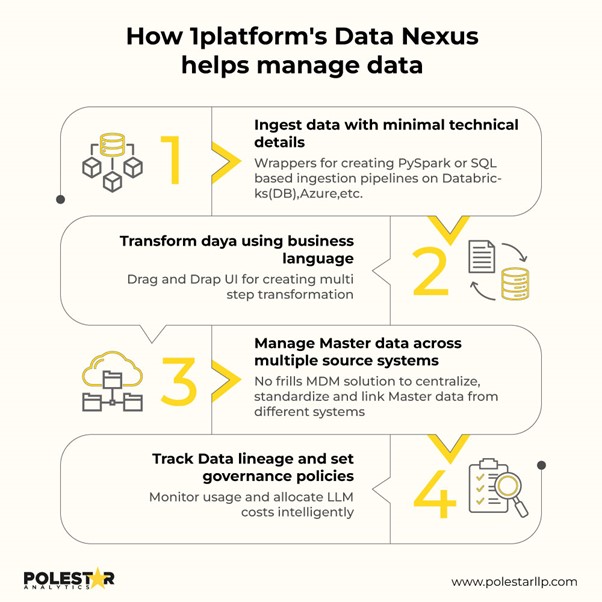
Organizations using Data Nexus and 1Platform today are building the infrastructure for tomorrow's autonomous operations.
The difference isn't sophistication—it's whether your architecture works for you or against you. It’s whether you are building on one platform or managing ten?
Decision is yours.
About Author

Information Alchemist
Without data you are just another person , with an opinion.